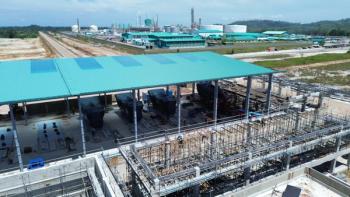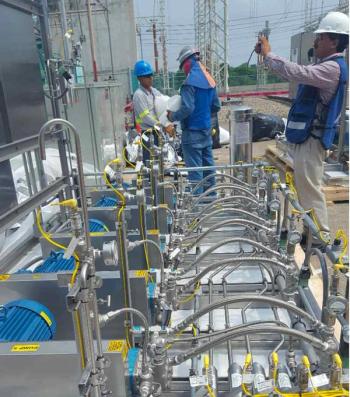
UNDERSTANDING HYDRODYNAMIC BEARINGS
AN OVERVIEW OF HYDRODYNAMIC BEARINGS, THEIR DEFINITION, THEORY OF OPERATION AND TROUBLESHOOTING TIPS
Hydrodynamic bearings (also known as fluid film bearings) are often deployed as journal bearings. As such, they come in several types, including radial tilting pad bearings, thrust bearings for axial displacement and journal sleeve bearings.
Journal sleeve bearings are typically used in low-speed and low-friction applications while radial tilting pad bearings are used for high-speed applications due to the high amplitude of vibrations.
Thrust bearings, on the other hand, are generally employed for axial displacement in high-speed applications as they contain tilting pads that support high-thrust loading of rotors.
Frictionless support
The journal bearing has several functions. It acts as a frictionless support for the rotor while it is rotating. It cools down the rotor by transferring the heat energy generated from the process gas to the rotor and then to the oil by convection, or from the process steam in the case of steam turbines. Another role is to dampen high-amplitude vibrations by means of pivoted tilting pads and an oil stream entering the bearing, which creates an oil film between the rotor and the bearing stationary pads.
The bearing itself consists of the journal region of the rotor and the bearing housing, containing the internal chamber of bearing and pivoted tilting pads. There is also a channel for oil entrance, an oil outlet and a thrust collar in the case of thrust bearings.
The bearing undergoes a hydrodynamic wedge effect as the rotor spins eccentrically inside the bearing housing at its normal operating speed. The rotor exerts a force on the oil enclosed between the rotor and the pads according to Newton’s second law and in accordance with oil’s incompressibility property.
The oil exerts a reaction force equal in magnitude on the rotor resulting in raising it upwards. This action is called the hydrodynamic or wedge effect. In other words, the heavy rotating rotor is supported by the hydrodynamic effect (viscous force).
The main parameter controlling hydrodynamic bearings is called “load carrying capacity” which determines the size of the bearing. This depends on oil pressure, temperature, flow rate, viscosity, oil film thickness and rotating speed. The load carrying capacity (LCC) is directly proportional to all of those parameters except for oil temperature, which is inversely proportional.
When oil pressure increases, it can generate vortices and eddies inside the bearing housing which can cause high-amplitude vibrations at a frequency equal to 0.45x of the rotating speed (oil whirling). When oil pressure decreases, it can lower the thickness of the oil film which can lead to a drop in the vibration damping ability so high-amplitude vibrations can occur.
Another point to note is that when oil temperature increases, it causes a decrease in oil viscosity which in turn leads to low oil film thickness, low vibration damping and an increased oil flow rate (the viscous effect will decrease).
However, when the opposite occurs (oil temperature decreases), there is greater vibration damping ability and a higher temperature difference between the rotor and the oil. This equates to better cooling which is a desirable condition for machine operation.
Other operational points:
• Lowering the rate of oil flow decreases the thickness of the oil film as well as oil pressure However, poor cooling of the rotor also occurs
• An increase in oil viscosity improves vibration damping and cooling
• Rotational speed is directly proportional to load-carrying capacity
• An increase in oil film thickness can cause vortices and eddies, but if the thickness decreases there will be low damping and a low heat transfer rate for rotor cooling.
Oil and vibration
Oil is controlled by means of the oil system. The oil temperature is controlled by oil coolers to maintain temperature within a constant accepted range. Oil pressure control valves maintain a constant pressure. An orifice maintains a constant oil flow rate during operation.
Vibrations are associated with rotational speed. 1x is a synchronous harmonic frequency equal to the speed of rotation. Imbalance can be due to mechanical factors (noted by rising vibration as rotor speed increases) or during operation because of fouling of process gas inside the impellers.
2x is a super synchronous, super harmonic that can be generated by misalignment or mechanical looseness. This can best be recognized by side frequencies associated with vibration frequency peaks.
Angular misalignment is indicated by an axial reading and a high 1x frequency compared with 2x frequency.
Parallel misalignment, or offset, on the other hand, is indicated by a radial (vertical) reading and a high 2x frequency compared to the 1x frequency.
Finally, oil whip instability may occur if the machine is operated at or above 2x the rotor’s critical frequency; oil whirl becomes oil whip instability as the shaft speed passes through 2x of the critical frequency.
Author
Amr Hatem Rashed is a Senior Turbomachinery Engineer at Abu-Qir Fertilizers Company in Alexandria, Egypt. He has a Master degree in mechanical engineering.
Newsletter
Power your knowledge with the latest in turbine technology, engineering advances, and energy solutions—subscribe to Turbomachinery International today.





